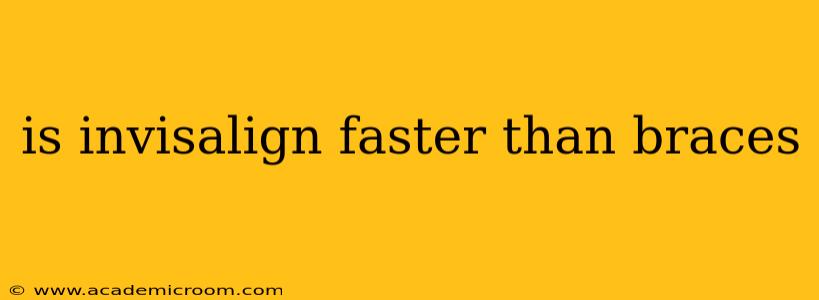The question of whether Invisalign is faster than braces is a common one, and the answer isn't a simple yes or no. While both Invisalign and traditional braces aim to straighten teeth, their mechanics differ, leading to varying treatment times. Let's delve into a detailed comparison to understand which option might be faster for you.
What is Invisalign?
Invisalign uses a series of clear, removable aligners to gradually shift teeth into their desired positions. Each aligner is worn for approximately two weeks before being replaced with the next in the series. The aligners are custom-made based on digital scans of your teeth, offering a discreet alternative to traditional metal braces.
What are Traditional Braces?
Traditional braces utilize brackets bonded to the teeth and connected by wires. These wires apply constant pressure to move the teeth, requiring regular adjustments by an orthodontist. Braces are a more visible option but have been a long-standing and effective method of orthodontic treatment.
Is Invisalign Always Faster?
The speed of Invisalign versus braces depends on several factors, and it's not always faster. While some cases may see quicker results with Invisalign, others may require a longer treatment time. Several factors influence the overall duration:
Severity of the Misalignment:
- Mild to Moderate Crowding or Spacing: In these cases, Invisalign can often complete treatment faster than traditional braces. The clear aligners can effectively address minor misalignments in a shorter timeframe.
- Severe Misalignment or Complex Cases: For severely crooked teeth, significant overbites, or underbites, traditional braces might be more effective and potentially faster. Complex cases often require more precise control over tooth movement, which braces provide better.
Patient Compliance:
- Invisalign: Success with Invisalign heavily relies on the patient's commitment to wearing the aligners for the recommended time each day (typically 20-22 hours). Inconsistent wear can significantly prolong treatment.
- Braces: While regular dental check-ups and adherence to the orthodontist's instructions are essential, the treatment itself is less dependent on patient compliance compared to Invisalign.
Orthodontist's Expertise:
The experience and expertise of the orthodontist play a vital role in determining the treatment duration for both Invisalign and braces. A skilled orthodontist can optimize the treatment plan to achieve the best results in the shortest possible time, regardless of the method used.
How Long Does Invisalign Typically Take?
The average Invisalign treatment time ranges from 6 to 18 months, but this can vary greatly depending on the factors mentioned above. Simple cases might take closer to 6 months, while more complex cases could extend to 18 months or longer.
How Long Does Traditional Braces Treatment Typically Take?
Traditional braces usually take 18 to 30 months, although this can also vary depending on individual needs and case complexity. Similar to Invisalign, simpler cases can often be completed in a shorter period, whereas complex cases require more time.
Can I Switch From Invisalign to Braces or Vice Versa?
Yes, it's possible to switch between Invisalign and traditional braces if your orthodontist deems it necessary. For example, if you experience difficulty with Invisalign compliance, or if your case proves more complex than initially anticipated, a switch to braces might be recommended. Conversely, if braces are proving too uncomfortable, your orthodontist might discuss transitioning to Invisalign, although this is less common.
Which is Right for Me?
Ultimately, the best option—whether Invisalign or braces—depends on your individual needs, case complexity, and preferences. A consultation with a qualified orthodontist is crucial to assess your situation and determine the most efficient and effective treatment plan. They will consider the severity of your misalignment, your lifestyle, and your goals to recommend the best approach for achieving a healthy, beautiful smile.
What are the Costs Involved?
The costs associated with both Invisalign and braces can vary significantly depending on location, the orthodontist's fees, and the complexity of the treatment. It's essential to discuss costs and payment options with your orthodontist during your initial consultation.
Does Insurance Cover Invisalign or Braces?
Many insurance plans offer coverage for orthodontic treatment, but the extent of coverage can differ. It's crucial to contact your insurance provider to determine your specific benefits and coverage for both Invisalign and braces. Some plans may cover a percentage of the costs, while others might require a higher out-of-pocket expense.
